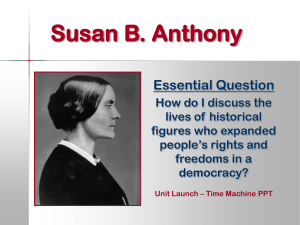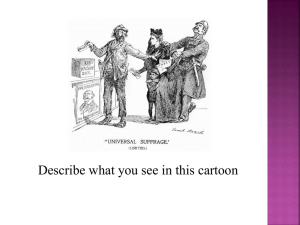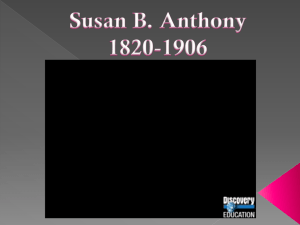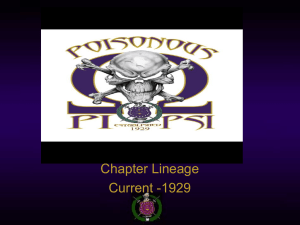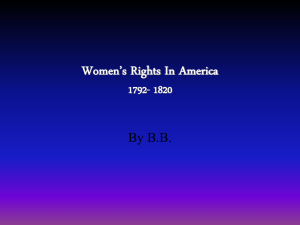The Geography of the Twin Cities St. Anthony Park
advertisement
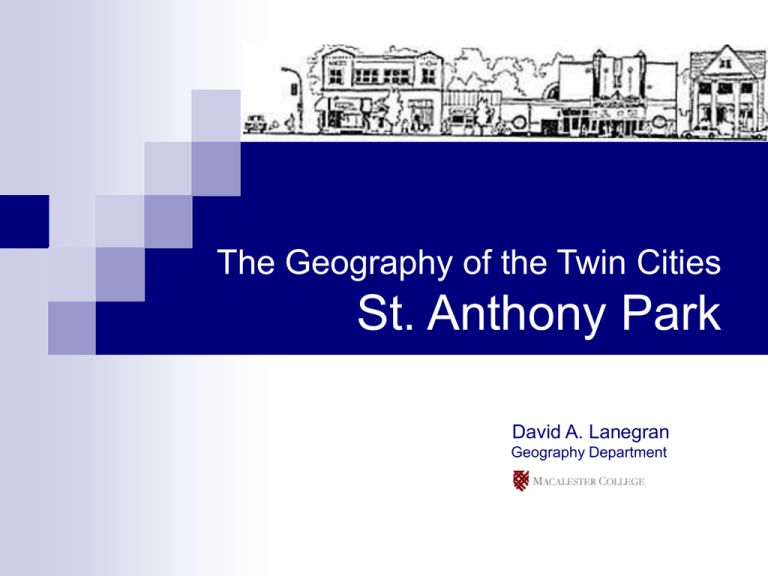
The Geography of the Twin Cities St. Anthony Park David A. Lanegran Geography Department St. Anthony Park was a railroad suburb that was expected to become an elite suburb for people living on the East Bank of the Mississippi near the falls of St. Anthony. However, the wealthy population of Minneapolis moved westward toward the Lake District, and St. Anthony Park was redesigned and reoriented toward Ramsey County and St. Paul. Today St. Anthony Park is one of the most successful communities in the Twin Cities; though it has long been under the influence of its neighbor, the St. Paul Campus of the University of Minnesota. At first a high school for farm boys, the University developed this campus into a series of special programs on agriculture and natural resources. Today the St. Paul Campus is an integral part of the University but maintains the programs on agriculture. Early faculty members settled in St. Anthony Park and worked hard to make it into their version of a "college town in the city." This 1874 map of Ramsey county shows St. Anthony Park in the western edge of the county. Like other railroad suburbs, the development was separated from other suburbs. The steam trains could not efficiently start and stop in short distances, so suburbs were spaced out along the track lines. When this map was made, the development was not incorporated. It became a part of St. Paul in the late 1880's, when the area between the city boundary and the western edge of the county was incorporated into the city. This is the plan for St. Anthony Park produced by Horace W. S. Cleveland in 1873. He was hired by Gov. Marshall on behalf of the promoters of the development. Cleveland's plan for St. Anthony Park is an interesting example of the sort of romantic suburb popular among the wealthy in the late nineteenth century. The general concepts he uses are articulated in his many writings. A devotee of natural-type gardening, he did not like strict formal plans and geometric regularity bored him. Instead, he wanted to use the natural contours of the land to improve the existing vegetation and site houses on irregular shaped lots. Cleveland's primary goal was to create lots which maximized the scenic potential of the area. Most lots had a combination of high land, slopes, and lowlands or marshes. The overall effect conformed to notions of the "picturesque." Developer Charles Pratt and builder William Clark at Langford Lake in about 1886. Pratt took over the development of St Anthony Park after the earlier plan failed. He intended to build a family-oriented, middle class neighborhood. He valued Cleveland's ideals but produced a more sellable community. Langford Lake was filled to make Langford Park. This is the developer Pratt and his family. It gives a good image of the community under construction, before the roads were paved and with only a few early houses in place. St. Anthony Park Railroad Station Plan for St. Anthony Park South The St Anthony Park Company divided the area into two sections. This design by Sewell produced a tight community that was split by the main line railroad tracks. The developers were careful to include some park space in the area. Lots to the east and south of the track were eventually converted to industrial use. This plat of St Anthony Park North shows the new concept of a middle class community but it also shows us one of the original lots: the large lot in the northern section of the community. This was the original site for the Luther Seminary. The contract between the Cleveland design and the actual community is quite remarkable. This rather fanciful view of St. Anthony Park appeared in the April 1886 issues of Northwest Magazine. It indicates what the promoters want the Park's image to be - a perfect combination of accessibility and rustic beauty. Early scene in community with Marshall's house, dimly visible on the hill north of Langford park. We see the original vegetation of the area. This is the house built by Marshall as a combination home and real estate office. He held a considerable piece of property that was a model of the new life possible in a suburban villa. View of the Marshall property taken from a glass negative. This view shows the tower from which prospective buyers were given a commanding view of the community. A close-up of the Marshall home with a good view of the rubble wall. Building with field stones or rubble was a popular way to give an impression of a rustic or arts and crafts style. Usually this technique was used on smaller houses but Marshall was using his house as a sign. House of Dr M. H. Reynolds on the corner of Blake and Langford Park West. This is a view of a basement being dug for one of the company's houses. This illustration of a street grading project appeared in an article about St. Paul's rapid growth in Harpers Weekly, in October of 1890. It probably represents Bourne Hill because this was the only suburb with steep slopes being developed at the time. Also, the buildings at the top of the hill resemble the Ellerbe and Southhall homes that had already been built by then. Mr. and Mrs. Edward C Hall and the family. The Victorian families were large and used every part of the house. The Hall House on Bayless. One of the Hall's daughters is in front of the house. Example of a middle class house built in the park. This one has made extensive use of spindle work. The houses along Evert Court were built by speculators during a down time in the housing market. They were rented for several years. The St. Anthony Park Company leadership believed that the ideal community should provide employment within an easy commute. This follows the ideas of Ebenezer Howard who was advocating Garden Cities as an antidote to the industrial cities of England. In addition, the area had excellent access to the railroad. A variety of industrial activities were developed here including stockyards, which were later replaced by the new facility in South St. Paul. Large Victorian villa. View of railroad and St Anthony Park industrial area near the old Raymond Avenue bridge. Commercial buildings at Carter and Como about 1920. The community had few commercial establishments in the interior. These buildings have become primary social space in the Park. The workforce of one of the industries in St. Anthony Park. Workforce of the Park Manufacturing Company (later the Gregg Manufacturing Co) in the early 1900s. The factory was located southeast of the Raymond Ave bridge and manufactured farm equipment. The Herbst's Como Avenue store was located in the Franke building. The Herbst family started a retail meat business in the 1880's in St. Anthony Park and has been in business in the area ever since. This scene is interesting because we can see how limited the supply of canned and packaged goods was. The store's primary function was to cut meat to order. The large walk-in cooler fills the back wall. The Midway Creamery was located on the corner of Como and Snelling, about 1915. It represents the numerous businesses on the edge of the Park that provided services and goods to the residents. The first location of the Allan Bros Grocery was on Raymond Avenue on the northwest corner of the bridge. Later they moved to the commercial block at Raymond and Hampden where they remained in business until the 1960s. The merchants provided home deliveries twice a day to households in the community. Housebound women could not walk and carry the groceries. Independent farmers also provided services to residents of the community. This is John Jorgensen's St. Anthony Park Dairy Wagon, in 1908. His business was started by his uncle in 1888 and covered area from Minnesota State Fair grounds to Como Avenue. In the 1920s Curtis's Northwest Airport was located at the southeast corner of Snelling and Larpenteur. There were several of these small airports during the 1920's. Most were converted to residential communities, but at the time no one was sure which field would be dominant. Eventually Northwest Orient Airlines emerged at Holman Field in downtown St. Paul. It soon out grew out of the St. Paul field and moved to the Wold-Chamberlain Field which became the Twin Cities International Airport. Members of the Froula Reading Circle about 1912. The women provided the mortar that held this and other residential communities together. In addition to staying at home with the children, they developed a variety of social and service organizations. Musical and literary organizations were very popular with the women who had attended high school but found few outlets for their academic interests and skills. The roles of women changed greatly during World War II. Huge labor shortages encouraged women to work in defense plants, like the Arden Hills Arsenal, located a few miles north of St. Anthony Park. Although most of the women working in defense plants returned to homemaking after the war, the old model of single income households was broken. The post-war baby boom filled the city's schools, most of which were built during the first two decades of the 20th Century. The pressure on the schools caused many changes in the residential areas of the city. Overcrowded schools and low pay caused a teachers strike in 1948. In the 1950's, the neighborhood began to formally organize activities that promoted community spirit. Of particular importance was the traditional Fourth of July celebration that expanded from patriotic activities to a community building program. Murray Students gather at Guertin's Drug Store for after-school socializing in this photo from the Murray Pilot of 1959. The existence of a K-12 education program within the community made it possible to build a very strong sense of local identity. School children spent most of their lives together while their parents worked on school programs and in the parent-teacher organization. From the very earliest years, there was a neighborhood organization in St. Anthony Park. At first it dealt with the development company and enforced covenants against free-running animals and other local issues. With incorporation, it concentrated its efforts on getting the city to deliver public services. For most of its history it was a men's organization. They were adept at lobbying. This is a photo of City Government Night. During its history, the Association served as a service club, a local Chamber of Commerce, civic improvement association, and political pressure group. Others believed its primary function was to support neighborhood athletic teams and recreation facilities. At various times it fulfilled all those functions. Members of the American Legion lead the 1958 Fourth of July parade past Como Avenue businesses. Parades are important statements of culture. They essentially claim space for the group and publicly state who the marchers are; in this case, it is the local community expressing itself by taking over the city streets. Change began to impact South St. Anthony; first the industrial area expanded and changed, putting demands on the surrounding community. The city government thought the old residential areas should be redeveloped for low income public housing and commercial activity; however, the residents resisted. The local residents, through their South St. Anthony Project Area Committee (which was sponsored by the Housing and Redevelopment Authority), produced mimeographed bulletins and fact sheets to state their case against the HRA. Elizabeth Clark, a local resident, became the spokesperson for the South St. Anthony Park residents. Many of the group's demands were not met. The neighborhood was not expanded, the housing that was built did not make provision to house displaced persons within the community, a library was not built, and the local school was closed. However, they did get a new recreation center, streets and lighting were improved, and more trees were planted. Seeley High-Rise and the Hampton developments were built in the community. Seeley High-Rise District 12 Community Council sponsored a successful "neighborhood clean day" in 1987. The District Council has taken over many of the advocacy functions of the local organizations. It presents a wide range of services for the communities and provides a communication link to city Government. This house at 923 Bayless Avenue is an example of the reinvestment that has occurred in the neighborhood. Residents of the area have long volunteered to help their neighbors. Here is Jerry Jenkins volunteering for Meals on Wheels. St Anthony Park continues to attract investment. Here we see a major renovation project under way. This slide show is based on the book by David Lanegran, St. Anthony Park: Portrait of a Community, St. Paul: District 12 Community Council (1987). The book is available from the District 12 Community Council. Copyright 2001


